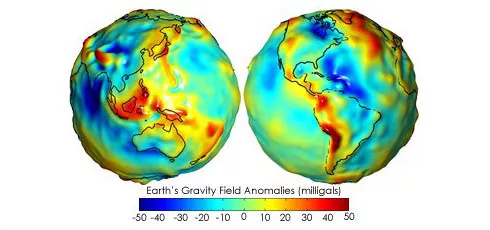Geoid vs. Ellipsoid: What’s the Difference?
For any worksite survey in which vertical measurement plays a significant role, the ability to accurately calculate local elevation is critical.
For quarries and mining sites, which deal with metrics like pit depths and shelf slopes, this may seem fairly obvious. The same goes for landfills, where staying up-to-date with cell volumes and remaining airspace is important for planning future work.
But even for earthwork on civil construction sites, where vertical measurements are smaller in scale (cut/fill remainders, stockpile heights, etc.), having the best local elevation data is key to accuracy—and thus smarter, more cost-efficient work.
To help you understand how Propeller uses coordinate reference systems and the science of geodesy to deliver highly accurate vertical measurements, we want to shed some light on a couple of often confusing concepts: ellipsoids and geoids.
Ellipsoids: a (slightly) more accurate model of the Earth’s surface
To start with, let’s dispel some conventional wisdom about our planet: it’s not spherical. (Don’t worry; your conspiracy theorist friends who say it’s flat aren’t right, either.)
More accurately, the shape of the Earth is an ellipsoid, sometimes referred to as a spheroid. While ellipsoids are round and smooth like spheres, they are not symmetrical when divided in all directions. Because the circumference of the Earth’s equator is about 42mi (67km) longer than its meridians, the planet cannot be described as a perfect sphere.
Scientists have developed several ellipsoidal models of the Earth over the years. The most well-known of these serves as the basis for the WGS84 coordinate reference system.
WGS84 is a geographic coordinate reference system, meaning it contextualizes a point on a 3D surface—in this case, the Earth—using degrees of latitude and longitude. If you’ve ever used GPS data, the coordinates were derived using WGS84.
By themselves, ellipsoidal models are primarily used to measure distances across the surface of the Earth when miles and kilometers, rather than inches and centimeters, make the difference. Think about charting a flight path or tracking continental drift over millennia.
Geoids: the uglier truth about our planet
Complicating things further, the earth’s surface is not actually smooth like these idealized ellipsoidal models. Because the density of the planet is inconsistent, gravitational forces pull in or push out the earth’s surface in different places, resulting in a planet that looks more like a lumpy potato than an egg.
Models that approximate the lumpy potato we call home are called geoids. The surface of a geoid represents a Mean Sea Level (MSL), or a conjecture of the ocean’s surface if tides, winds, and other factors that affect its movements didn’t exist. The only factor that affects the MSL’s shape is the earth’s gravity field.

Unlike ellipsoidal models, geoid models are locally based—or, at least, more local than the entire surface of the Earth. For instance, surveyors in the United States currently use the North American Vertical Datum of 1988 (NAVD88).
That is, they will for the next couple of years. The National Geodetic Society is set to replace the NAVD88 in 2022 with a newer model derived using GPS rather than the physical survey marks used by the current model.
How we use vertical datums to keep your data consistent
Both ellipsoid and geoid models (of which there are many) are examples of vertical datums. For surveyors, vertical datums serve as reference points from which elevation (positive altitudes and negative depressions) can be determined.
There are actually two types of vertical datums: tidal and geodetic datums. For our purposes, let’s ignore tidal datums, which concern the interface between the ocean and land, and are therefore less applicable to most surveyors.
Fractions of an inch matter in surveying, which is why it’s critical that surveyors use the same geodetic datums throughout the lifecycle of a project. Switching ellipsoid or geoid models midstream causes data discrepancies.
If you have data sets that use different coordinate reference systems and datums (such as a topographical survey and a design file) you need to transform one to match the other. Otherwise, the measurements won’t line up.
Propeller has developed an easy-to-use coordinates converter to help with this. It’s also a helpful tool for establishing local grids, or arbitrarily defined coordinate reference systems that are specific to one site.
When it comes to converting elevation data, there are three types of height to keep in mind:
- Ellipsoid height (h) is the difference between the ellipsoid and a point on the Earth’s surface. It is also called the geodetic height (not to be confused with geodetic datums). If you have coordinates that were captured with a GPS receiver, the elevation data reference the ellipsoid, meaning it has to be transformed to match the more accurate geoid instead.
- Geoid height (N) is the offset value between the reference geoid and the ellipsoid models.
- Orthometric height (H)—AKA the one you really care about— is the distance between a point on the Earth’s surface and the geoid. As we already discussed, the geoid represents Mean Sea Level. When you hear elevation data described as “X feet above (or below) sea level,” that’s referring to orthometric height.
To deliver consistent orthometric heights across your site, we use your chosen datums and this simple formula: H = h – N. Simple, right?
At Propeller, we pride ourselves on our ability to provide the most accurate drone survey data possible.




